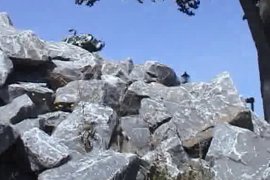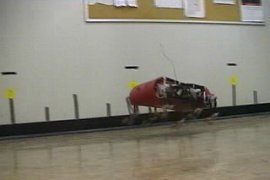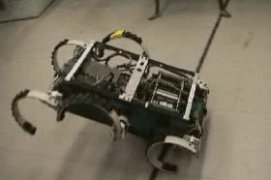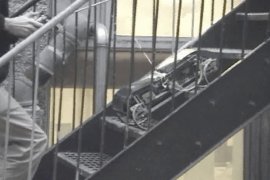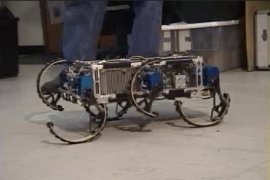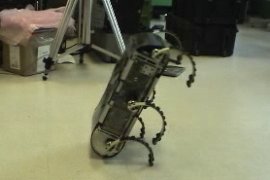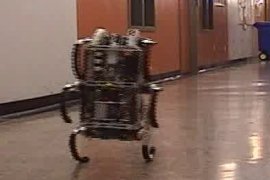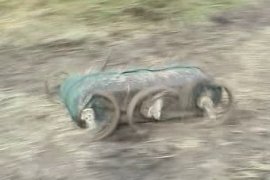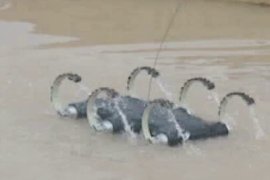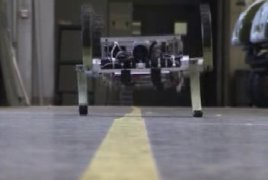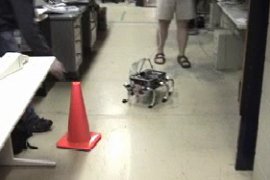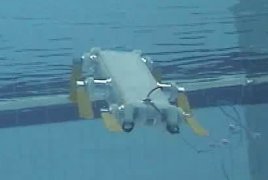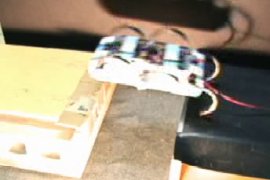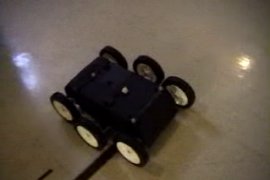| History |
| Capabilities |
| Movies |
| Publications |
| Links |
| People |
Summary of the RHex robot platform
This page summarizes the RHex project by giving a brief history, outlining its latest capabilities, illustrated with images and videos and presents relevant publications and links for further inquiryHistory
RHex project spawned from the DARPA CBS/CBBS program in 1998, funded with $5 million over 5 years. The first prototype was built by Uluc Saranli in 1999, followed by numerous revisions and improvements on the platform design and the algorithms. The following sequence of images shows the progress on the platform.
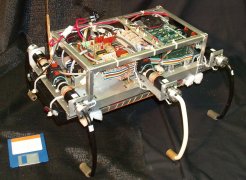 |
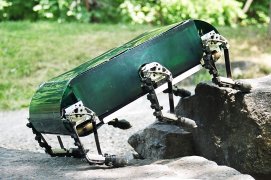 |
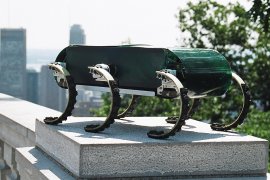 |
| RP0 Prototype | RHex 0.8 | RHex 0.9 |
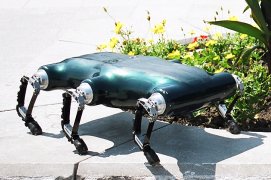 |
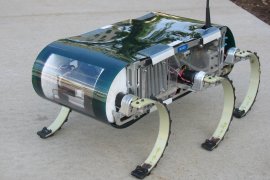 |
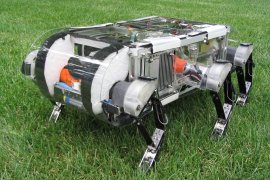 |
| Shelley | RHex 1.1 (with camera) | RHex 1.1 with Leg Sensors |
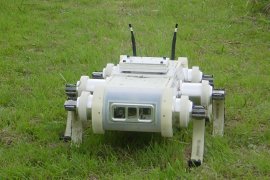 |
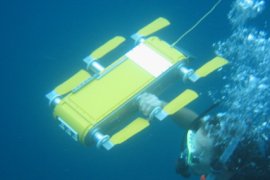 |
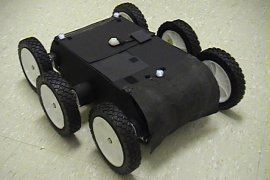 |
| Rugged RHex | Aqua | Wheel RHex |
Towards the end of the project, 30 researchers from the following institutions took part in various aspects of research and development
- The University of Michigan, Ann Arbor, MI
- McGill University, Montreal, Canada
- Carnegie Mellon University, Pittsburgh, PA
- University of California, Berkeley, CA
- Princeton University, Princeton, NJ
- Cornell University, Ithaca, NY
Capabilities
Throughout its development, RHex acquired a large number of capabilities in its behavioral repertoire. In fact, it is the only robot that is capable of performing such a wide variety of behaviors as a single, autonomous robot. This performance is due to the significant amount of inspiration from the study of biological systems, leading to a number of principles underlying RHex's design.- The use of legs instead of wheels or tracks opens the way for a large number of behaviors
- Passive compliance in the legs overcomes limitations of underactuation and helps simplify mechanical design, yielding robustness
- Sprawled posture, inspired from insects, results in passive stabilization of lateral motion
- Control is open-loop at the gait level, but closed loop at the task level. Stability comes as a result of passive mechanics, not high-bandwidth active control
At the end of the project's five years, RHex was capable of performing the following, mostly open-loop behaviors
- Running on reasonably flat, natural terrain at speeds up to 5 body lengths per second (just over 2.25m/s)
- Climbing a wide range of stairs
- Climbing slopes up to 45 degrees
- Traverse obstacles as high as 20cm (about twice RHex's leg clearance)
- Continuously run for 45 minutes, covering up to 3 miles with an efficient gait
- Successfully traverse badly broken terrain with large rocks and obstacles
- Walk and run upside down
- Flip itself over to recover nominal body orientation
- Leaping across ditches up to 30cm wide
- Support remote control from up to 150m distance
in addition to a number of behaviors that increasingly relied on feedback from sensors such as the onboard gyro, camera and strain gauges on the legs.
- Perform autonomous stabilization of yaw heading while running using feedback from the gyro
- Autonomously follow a line on the ground without any operator control
- Perform simultaneous localization and mapping by using artificial landmarks scattered over natural terrain
- Locomote on only two legs using active pendulum stabilization
- Autonomously change the rest lengths of its leg springs
- Autonomously run systematic experiments to tune its running gaits
- Use inertial sensors in combination with leg strain gauges to accurately estimate its body pose
Despite this large list of capabilities, there are still numerous open problems within the RHex morphology. Firstly, the flexibility of its legged design leaves significant room for additional behaviors. Furthermore, its high mobility over natural terrain opens up new possibilities for specific application domains for which components to achieve autonomy are still in their infancy. Finally, commercialization of the RHex platform requires significant platform development as well as further behavioral research to improve its performance.
Movies
Publications
| [1] |
A. Greenfield, U. Saranli, and A. A. Rizzi.
Solving models of controlled dynamic planar rigid-body systems with
frictional contact.
International Journal of Robotics Research.
24(11):911-931, 2005. [ bib | .pdf ] |
| [2] |
U. Saranli, A. A. Rizzi, and D. E. Koditschek.
Model-based dynamic self-righting maneuvers for a hexapedal robot.
International Journal of Robotics Research, 23(9):903-918,
September 2004. [ bib | .pdf ] |
| [3] |
U. Saranli, M. Buehler, and D. E. Koditschek.
RHex: A simple and highly mobile robot.
International Journal of Robotics Research, 20(7):616-631,
July 2001. [ bib | .pdf ] |
| [4] |
R. Altendorfer, N. Moore, H. Komsuoglu, M. Buehler, H. B. Brown Jr.,
D. McMordie, U. Saranli, R. J. Full, and D. E. Koditschek.
RHex: A biologically inspired hexapod runner.
Autonomous Robots, 11(3):207-213, 2001. [ bib | .pdf ] |
| [5] |
R. Altendorfer, U. Saranli, H. Komsuoglu, D. E. Koditschek, Jr. H. B. Brown,
M. Buehler, N. Moore, D. McMordie, and R Full.
Evidence for spring loaded inverted pendulum running in a hexapod
robot.
In D. Rus and S. Singh, editors, Experimental Robotics VII,
Lecture Notes in Control and Information Sciences, chapter 5, pages 291-302.
Springer, December 2000. [ bib | .pdf | .ps.gz ] |
| [6] |
U. Saranli, A. A. Rizzi, and D. E. Koditschek.
Multi-point contact models for dynamic self-righting of a hexapod
robot.
In Proceedings of the Sixth International Workshop on the
Algorithmic Foundations of Robotics (WAFR '04), pages 75-90,
Utrecht/Zeist, The Netherlands, July 2004. [ bib | .pdf ] |
| [7] |
U. Saranli and D. E. Koditschek.
Template based control of hexapedal running.
In Proceedings of the IEEE International Conference On
Robotics and Automation, volume 1, pages 1374-1379, Taipei, Taiwan,
September 2003. [ bib | .pdf | .ps.gz ] |
| [8] |
U. Saranli and D. E. Koditschek.
Back flips with a hexapedal robot.
In Proceedings of the IEEE International Conference on
Robotics and Automation, volume 3, pages 2209-2215, Washington, DC, May
2002. [ bib | .pdf | .ps.gz ] |
| [9] |
H. Komsuoglu, D. McMordie, U. Saranli, N. Moore, M. Buehler, and D. E.
Koditschek.
Proprioception based behavioral advances in a hexapod robot.
In International Conference on Robotics and Automation,
volume 4, pages 3650-3655, Seoul, Korea, 2001. [ bib | .pdf | .ps.gz ] |
| [10] |
M. Buehler, U. Saranli, D. Papadopoulos, and D. E. Koditschek.
Dynamic locomotion with four and six legged robots.
In Proceedings of the International Symposium on Adaptive Motion
of Animals and Machines, August 2000. [ bib | .pdf ] |
| [11] |
U. Saranli, M. Buehler, and D. E. Koditschek.
Design, modeling and preliminary control of a compliant hexapod
robot.
In Proceedings of the IEEE International Conference On
Robotics and Automation, volume 3, pages 2589-96, San Francisco, CA, USA,
April 2000. [ bib | .pdf | .ps.gz ] |
| [12] |
U. Saranli, W. J. Schwind, and D. E. Koditschek.
Toward the control of a multi-jointed, monoped runner.
In Proceedings of the IEEE International Conference On
Robotics and Automation, volume 3, pages 2676-82, New York, 1998. [ bib | .pdf | .ps.gz ] |
| [13] |
M. Buehler.
Dynamic Locomotion and Energetics of RHex, a Six-Legged Robot.
The Physiologist, 45(4):340, August 2002. |
| [14] |
M. Buehler.
Dynamic Locomotion with One, Four and Six-Legged Robots.
Journal of the Robotics Society of Japan, 20(3):15-20, April 2002. [ .pdf ] |
| [15] |
D. Campbell and M. Buehler.
Preliminary Bounding Experiments in a Dynamic Hexapod.
In Bruno Siciliano and Paolo Dario, editors, Experimental Robotics VIII, p. 612-621, Springer-Verlag, 2003. [ .pdf ] |
| [16] |
N. Neville, M. Buehler.
Towards Bipedal Running of a Six Legged Robot.
In Proceedings of the 12th Yale Workshop on Adaptive and Learning Systems, May 2003. [ .pdf ] |
| [17] |
D. McMordie, C. Prahacs, M. Buehler.
Towards a Dynamic Actuator Model for a Hexapod Robot.
In Proceedings of the 2003 IEEE Int. Conf. on Robotics and Automation (ICRA). [ .pdf ] |
| [18] |
D. Campbell, M. Buehler.
Stair Descent in the Simple Hexapod 'RHex'.
In Proceedings of the 2003 IEEE Int. Conf. on Robotics and Automation (ICRA). [ .pdf ] |
| [19] |
E. Z. Moore, D. Campbell, F. Grimminger, and M. Buehler.
Reliable Stair Climbing in the Simple Hexapod 'RHex'.
In Proceedings of the 2002 IEEE Int. Conf. on Robotics and Automation (ICRA) Vol 3, pp 2222-2227, Washington, D.C., U.S.A., May 11-15, 2002. [ .pdf ] |
| [20] |
M. Buehler.
RePaC design and control: Cheap and fast autonomous runners.
In Proceedings of the 4th Int. Conf. on Climbing and Walking Robots Karlsruhe, Germany, September 24 - 26 , 2001. [ .pdf ] |
| [21] |
D. McMordie and M. Buehler.
Towards Pronking with a Hexapod Robot.
In Proceedings of the 4th Int. Conf. on Climbing and Walking Robots Karlsruhe, Germany, September 24 - 26 , 2001. [ .pdf ] |
| [22] |
E.Z. Moore and M. Buehler.
Stable Stair Climbing in a Simple Hexapod.
In Proceedings of the 4th Int. Conf. on Climbing and Walking Robots Karlsruhe, Germany, September 24 - 26 , 2001. [ .pdf ] |
| [23] |
P.-C. Lin, H. Komsuoglu, D. E. Koditschek.
Sensor Data Fusion for Body State Estimation for a Hexapod Robot with Dynamical Gaits.
In Proc. IEEE Int. Conf. Robotics and Automation (ICRA), pp4744-4749, Barcelona, Spain, April 2005 [ .pdf ] |
| [24] |
S. Skaff, A. Rizzi, H. Choset, P.-C. Lin.
A Context-Based State Estimation Technique for Hybrid Systems.
In Proc. IEEE Int. Conf. Robotics and Automation (ICRA), pp3935-3940, Barcelona, Spain, April 2005 [ .pdf ] |
| [25] |
P.-C. Lin, H. Komsuoglu, D. E. Koditschek.
Toward a 6 DOF Body State Estimator for a Hexapod Robot with Dynamical Gaits.
In IEEE/RSJ International Conference on Intelligent Robots and Systems (IROS), pp2265-2270, Sendai, Japan. September 2004. [ .pdf ] |
| [26] |
P.-C. Lin, H. Komsuoglu, D. E. Koditschek.
Legged Odometry from Body Pose in a Hexapod Robot.
In IFRR 9th International Symposium on Experimental Robotics (ISER), Singapore. June 2004. [ .pdf ] |
| [27] |
P.-C. Lin, H. Komsuoglu, D. E. Koditschek.
A Leg Configuration Sensory System for Dynamical Body State Estimates in a Hexapod Robot.
In Proc. IEEE Int. Conf. Robotics and Automation (ICRA), pp1391-1396, Taipei, Taiwan, September 2003. [ .pdf ] |
| [28] |
S. Skaff, G.A. Kantor, D. Maiwand, and A.A. Rizzi.
Inertial navigation and visual line following for a dynamical hexapod robot.
In Proc. of 2003 IEEE/RSJ International Conference on Intelligent Robots and Systems (IROS), Vol 2, pp808-1813, October 2003. [ .pdf ] |
Links
- Official RHex web site
- Another good summary of the RHex platform. including media coverage
- Robotics Institute project page
People
Middle East Technical University
- Faculty
- Asst. Prof. Afşar Saranlı
- Prof. Kemal Leblebicioglu
- Asst. Prof. Yiğit Yazıcıoğlu
- Graduate Students
- Tülay Akbey
- Murat Deniz Aykın
- Orkun Oğucu
- Yasemin Özkan
- Ege Saygıner
- Gülhan Serhat
- Ferit Üzer
- Mert Ankaralı
Bilkent University
- Faculty
- Asst. Prof. Uluç Saranlı
- Graduate Students
- Ömur Arslan
- Akın Avcı
- Sıtar Kortik
- Cihan Özturk
- Tuğba Yıldız
Past Schools and Researchers
The University of Michigan
- Faculty
- Prof. Daniel Koditschek
- Postdoctoral Associates
- Dr. Richard Altendorfer
- Richard Groff
- Graduate Students
- Rahul Bagdia
- Richard Groff
- Kapil Jain
- Haldun Komsuoğlu
- Pei-Chun Lin
- Gabriel Lopes
- Joel Weingarten
- Undergraduate Students
- Joseph Raisanen
- Katherine Scott
- Engineers
- Karen Coulter
McGill University
- Faculty
- Prof. Martin Buehler
- Graduate Students
- Don Campbell
- Neil Neville
- Project Scientists
- Dave McMordie
- Chris Prahacs
- Aaron Saunders
- Matthew Smith
University of California, Berkeley
- Faculty
- Prof. Robert Full
- Postdoctoral Associates
- Dr. Noah Cowan
Carnegie Mellon University
- Faculty
- Dr. Alfred Rizzi
- Postdoctoral Associates
- Dr. Uluç Saranlı
- Graduate Students
- Ravi Balasubramanian
- G. Clark Haynes
- Jonathan Hurst
- David Maiwand
- Sarjoun Skaff
- Project Scientists
- Ben Brown
- Dr. Jay Gowdy
- Dr. George Kantor
[ Top | History | Capabilities | Movies | Publications | Links | People ]

